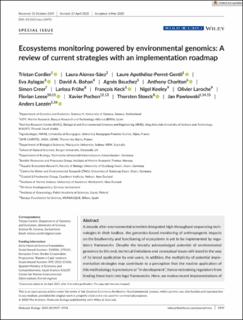| dc.description.abstract | A decade after environmental scientists integrated high-throughput sequencing technologies in their toolbox, the genomics-based monitoring of anthropogenic impacts on the biodiversity and functioning of ecosystems is yet to be implemented by regulatory frameworks. Despite the broadly acknowledged potential of environmental genomics to this end, technical limitations and conceptual issues still stand in the way of its broad application by end-users. In addition, the multiplicity of potential implementation strategies may contribute to a perception that the routine application of this methodology is premature or “in development”, hence restraining regulators from binding these tools into legal frameworks. Here, we review recent implementations of environmental genomics-based methods, applied to the biomonitoring of ecosystems. By taking a general overview, without narrowing our perspective to particular habitats or groups of organisms, this paper aims to compare, review and discuss the strengths and limitations of four general implementation strategies of environmental genomics for monitoring: (a) Taxonomy-based analyses focused on identification of known bioindicators or described taxa; (b) De novo bioindicator analyses; (c) Structural community metrics including inferred ecological networks; and (d) Functional community metrics (metagenomics or metatranscriptomics). We emphasise the utility of the three latter strategies to integrate meiofauna and microorganisms that are not traditionally utilised in biomonitoring because of difficult taxonomic identification. Finally, we propose a roadmap for the implementation of environmental genomics into routine monitoring programmes that leverage recent analytical advancements, while pointing out current limitations and future research needs. | en_US |
